The Dark Side of the Hut, 50 Years Later by John Sundman (Senegal)
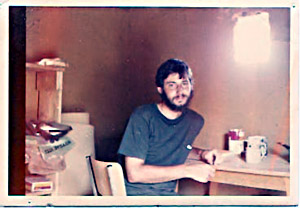
As a Peace Corps Volunteer (Senegal 1974-76) assigned to a rural development program I was posted to Fanaye Diery (‘fah-nigh jeery’), a HalPulaar village of about 500 people in the Senegal River valley, arriving there in late spring, 1974. (The HalPulaar people take their name from their language: HalPulaar means ‘Pulaar speaker’.)
In Fanaye, most houses were made of adobe. Some had thatched roofs; the larger ones had roofs made of adobe held up by wooden timbers. In anticipation of my arrival, the people of Fanaye had prepared a thatched hut for my residence. It was about 10’ square, with two window openings and a wooden door. Somehow I acquired a small table and a chair. I later hired someone to make a little bookshelf for me.
I slept on a mat on the floor. The only other amenity was a terra cotta jug that held about a gallon of water, which was replenished daily with water from a nearby well.
A little distance away, sheltered by the walls of a roofless abandoned building, was the concrete-lidded latrine I hired someone to dig for me as my first order of business.
There was no electricity in Fanaye, nor running water. The nearest post office was in Podor, which could take most of a day to get to, depending on the vagaries of travel. I had a post office box in Podor; letters took about two weeks to get there from the US. That post office was my link to my life back home in America.
Every once in a while — Fourth of July, Thanksgiving, random business — I’d get together with other Americans, either in St. Louis (also called N’Darr), a small city three hours distant from Fanaye by car, with a kind of New Orleans look, near the place where the Senegal River enters the Atlantic Ocean; or more rarely, in Dakar, Senegal’s capital city (10 hours distant under optimal conditions). But for most of the time over more than a year and a half I resided in Fanaye. I liked it there. I liked it a lot.
The drought
The key thing to keep in mind as you read this story is that it takes place in the context of the great drought, la grande secheresse, which had started about six years before I arrived in Senegal. That region of Africa is known as the Sahel, an Arabic word meaning ‘fringe;’ as it is the southern fringe of the Sahara Desert. So as you would expect, even in non-drought years it is very dry, something like the American Southwest. But during the great drought conditions became even more extreme.
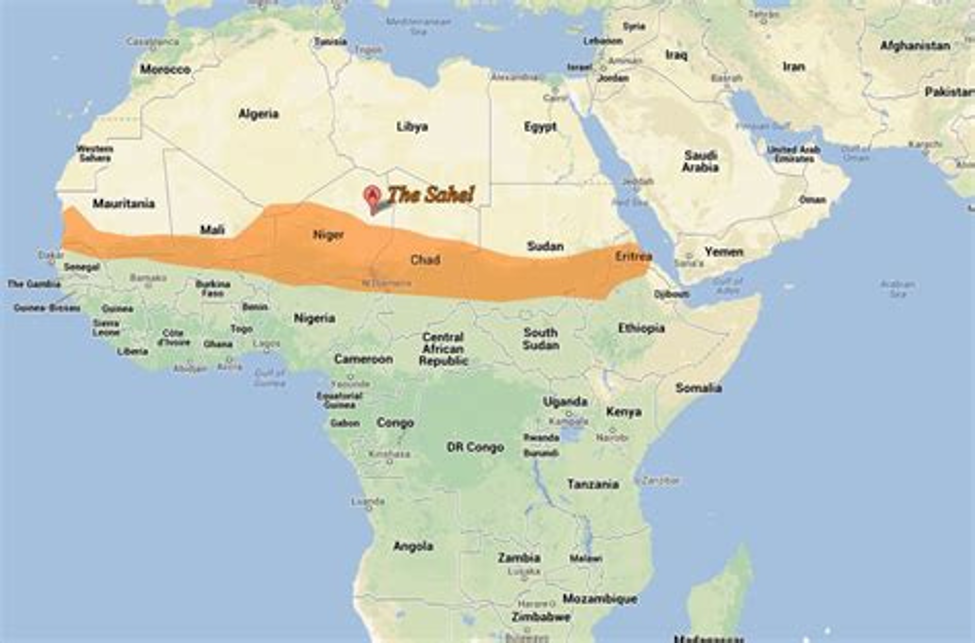
The HalPulaar people were cattle herders, but no cattle remained in Fanaye by the time I arrived there; the only livestock were goats and chickens — and a few horses. Every once in a while people arrived from the north by way of camels, so I guess that’s livestock too.
For six years their crops had mostly failed. Had it not been for the emergency food rations from the USA, EU, France and Saudi Arabia there would have been very little for us to eat. My diet consisted mostly of field corn and sorghum from the US, wheat (made into bread) from the European countries, dates from Saudi — plus some small bony fish from the nearby river, and, once in a while, some goat’s milk. There was also corn-soya-milk, from UNICEF, for the children.
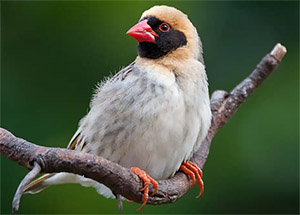
A mange-mil bird
The drought wasn’t just marked by an absence of rain, the entire ecosystem was simply out of whack. There were plagues of rats that ran in herds like bison on the Great Plains of America before the settlers with guns showed up. Fungi ruined whatever grain one might have managed to store, swarms of locusts came and blotted out the sun, wild boars rooted up any plants that manage to sprout, and mange-mil birds with needle-beaks sucked the juice out of individual grains of sorghum or millet.
Days, weeks, months went by with nothing but clear, hot, blue skies. Then, when what should have been the rainy season came, the clouds appeared. Every day the clouds got a bit thicker. Every day it looked more like a downpour was immanent. At night the winds would pick up. Dust would swirl. There would be thunder and lightning. Oh, it’s going to rain, it’s finally going to rain, at last!
But then, nothing. Not one drop. From time to time I would find myself humming a song I had been taught in second grade:
Oh,
It ain’t gonna rain no more, no more
It ain’t gonna rain no more
How in the heck can I wash my neck
If it ain’t gonna rain no more, no more?
I remember that that song had deeply scared me until my mother reassured me that it was just a song, and that indeed there would always be rain. Even if it wasn’t raining today, she said, someday soon it would rain again, and we would have water to drink and to take baths and water the gardens. But in Fanaye it wasn’t so easy to believe that the rain would ever come back.
Rural animation
I was part of a program of the government of Senegal called ‘Animation Rurale,’ which was intended to connect people in the remoter areas with available government services. In this way we were kind of like county agricultural extension agents in the USA. (If you didn’t grow up on a farm or study agriculture at a land-bank university like I did, you can be forgiven for not knowing that ‘county agents’ are still very much a thing.)
In Senegal, the U.S. embassy had a so-called ‘self-help’ fund that we Peace Corps animateurs could use. If the local people provided labor, the U.S. would provide money for locally-initiated improvements.
After the 2 months or so of language, cultural awareness, and similar training in Dakar, my assignment was basically this: Go to Fanaye, get to know the people there, become fluent in the language, help improve the connection between the local people and the regional government services, and ask the people what kind of project they would like help to undertake with money from the self-help fund.
(Of the 110 or so Peace Corps Volunteers in Senegal at that time, about 80 were teachers in secondary schools that were located in cities or larger towns; many PCVs taught English. Only about 30 of us were animateurs, living in smaller, remoter villages.)
In Fanaye, there was an elementary school teacher paid and managed by the national government, teaching the national elementary school curriculum. But there was no school building. The children sat on the sand for their lessons under a thatch roof.
The project the people wanted me to help them with, they told me after I had been living among them for a few months and was no longer a stranger, was a school. If the United States would provide money for cement and roofing materials and tables and chairs and some blackboards, they would build the building. So, over the next year and a half, that’s what I helped them do. But that’s another story.
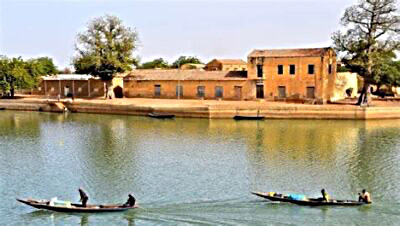
The thriving metropolis of Podor, day’s travel away from, is where I went to get my mail, hitchhiking there about once every two weeks.
Languages and dreams and living without a mirror
In Senegal, French is the official language of government and Wolof is the lingua franca of the people. During in-country training in Dakar before being sent to our posts, most PCVs were taught Wolof and French. But since I was deemed fluent in French I was taught Wolof and Pulaar.
In Fanaye, many of the older men spoke a bit of French, which they had picked up either while serving in the French army, or while working in France as busboys, street cleaners, construction laborers or the like. (This was a great asset to me in learning Pulaar.) All of the men, and a smaller portion of the women, were fluent in Wolof, or nearly so. Government employees — such as the school teacher, nurse at a local clinic, the worker at a local agricultural experiment station — all knew French. There was even a veterinarian there for a while, although he had absolutely nothing to do. These civil servants were from different parts of the country, from various ethnic groups, and when they got together they spoke Wolof with each other. Except when I was there, they switched to French as a courtesy to me. But the villagers, among each, other spoke Pulaar.
I learned to get by in Wolof, but over time I became much stronger in Pulaar. At some point I even began dreaming in Pulaar. I remember waking up one morning and realizing that my mother and my sister Maureen had been in my dream. Only, in my dream they were Black and spoke Pulaar. I didn’t have a mirror in Fanaye, and on those occasions when I got out of the village and visited friends in places like Dakar or St. Louis and saw myself in a mirror it was always kind of a shock to be reminded how white I was.
Dieri and Oualo
The words dieri and oualo (‘jeery’ and ‘wallo’) refer to two kinds of soil and the two kinds of agriculture that go with them. Dieri soils are sandy and rely on rain (or irrigation) to grow crops. Oualo soils are clayey; they form the flood plain of the Senegal River. After the annual flood recedes, oualo soil forms a hard crust that prevents water from evaporating. This soil can support crops that grow for months without being watered.
During the drought the floods still came to Fanaye because the headwaters are a thousand miles to the south, in hills and jungles where the rains had not stopped. In normal times, when there was rain, the farmers of Fanaye would grow millet and squash and melons in the dieri soil. But during the drought none of that grew. In the oualo they grew sorghum and beans. When I was there, most of those crops that grew in the oualo were destroyed by the pests I mentioned earlier — locusts, birds, rats, birds. Even wild boars.
In a satellite view you can tell oualo from dieri at a glance. The dieri, on the bottom half of a picture, looks like a sandbox — which it basically is. In the oualo, green, and you can see the winding Senegal River and a few of its smaller offshoots.
Cowboys and Indians
Fanaye was an established place with a long history. The people were muslims; they prayed five times each day, and every evening the older men went to the mosque, which was a hundred years old, and sat in a circle and chanted la ilaha illa Allah for nearly an hour.
In that region of the country there were also people usually known as Peuhls (a Wolof name for the Fula people). HalPulaar people (as I understand this, I’m no expert) are closely related to the Fula — indeed Pulaar is a dialect of the Fula language, which known as Fulani — but they are distinct peoples.
When I was living in Senegal, every Peuhl person I met was a nomad. Sometimes several of them would pass through Fanaye with their flock of goats — arriving from one direction, leaving in another. They had a reputation among local people in Fanaye for being taciturn and desert-hardened. They lived by their own rules and didn’t want anything to do with officialdom, it was said. I did have a few conversations with Peuhl people passing through, but they weren’t especially friendly, as I recall. And clearly the languages we spoke were different, even if mutually intelligible. Perhaps something like Swedish and Norwegian?
I have a funny story (for another time) about how one Peuhl fellow expressed to me what he thought about religious piety. Short version: not much. My point is that even as Fanaye came to me to feel more and more like home, the life led by the Peuhl people seemed a bit mysterious and exotic to me.
One day I asked my friend the school teacher about the relationship between these two groups — the sedentary HalPulaar farmers and the nomadic Peulh shepherds. He replied in English — the only time I ever heard him do so — “We’re the cowboys,” he said. “They’re the Indians.”
Well well well
As the drought wore on, people in the government and in relief agencies began to worry that a humanitarian crisis was looming. To date they had been able to prevent famine with the help of food donated from abroad. But what about water? Even in the interior, far away from the river, there were wells. But the here and there wells were going dry as the water table sank. With no water in the wells, people would be forced to leave. But where would they go? The specter of refugee camps was starting to take shape, and it was frightening.
In Dakar, the US and Senegal came up with a plan: The United States would put up the money, and the government of Senegal, with the help of Peace Corps Volunteers, would identify places that needed wells to be deepened or new wells dug. (I have a funny story about how we put together the budget for this project, but this post is already much too long, so that story can wait.)
So the next problem was: where should we put these wells?
It was easy enough to identify well targets in established places like Fanaye, but how would we find the right places to put wells that would help the Peulhs? They were largely disconnected from the government. They kept to themselves. There were no roads in the deep parts of the dieri where they grazed their goats (and their cows, presumably, before la secheresse killed most of them). The maps we had were all provisional. If a map indicated that a village was at place X, that only meant that it was there when the map had been made. These people moved around. Who knew if that village was still there today.
This unmapped, roadless interior was called by some of my Senegalese colleagues, le bled.
By donkey cart into the void
And so it came to pass that I found myself on a donkey cart with a Senegalese official — I’ll never remember what his title was; he was just a worker bee like me — and a map, and a compass, and a lot of water, and a guide who swore he knew where he was going. I sure hoped he knew where he was going, because if we got lost, heaven help us. And thus we set off to find this rumored village, somewhere out there in that vast emptiness south of Fanaye, that might need a well. I felt as I suppose Col. Percy Harrison Fawcett might have felt as he set off into the Amazon jungle in search of the Lost City of Z.
But indeed, after about 3 hours we arrived at the village we had been looking for. Children ran out to see us crying toubab! toubab! (I was probably the first white person any of them had seen). It was a small encampment, the buildings there were all made of branches from local scrub brush, covered, I seem to recall, with goat hides. I want to say there were about 30 people, but I really don’t remember. There were goats and even some emaciated cattle. And a single, forlorn, unlined well.
When the reason for our visit was made clear — that we wanted to give them a new, deep, cement-lined well, and we just wanted to know where they were and if that was OK with them — there was much rejoicing, and I, in particular, was treated as royalty.
After a bit of back and forth I gave into their strong request that I accept the honor of sitting in the finest hut the village had to offer. Now, this was the last thing I wanted to do — to go sit, by myself, in a hot hut, while the people, the discussion, the sights and sounds were just outside. But it became clear that it would be rude of me to refuse. And then they brought in something unspeakable precious for me to drink: fresh cow’s milk, sweetened with a bit of rock sugar.
You have to understand that I had scrupulously avoided drinking any raw milk for a year and a half because there was tuberculosis in Senegal and you could catch it, we were instructed in our training, from drinking raw milk. But I said to myself, “oh well,” and I drank it, as some of my new friends peered at me through the door, waiting to see my reaction. And indeed it was refreshing, and I was able to tell them so in their language, which delighted them.
And then, and then and then. You’re not going to believe this, but I swear on all things holy, that this is what happened next.
Surely some great revelation is at hand
And then a young man appeared, and he set before me, on the sandy floor of that hut, a battery powered record player. And he produced a cardboard sleeve that contained a vinyl record, which he proceeded to withdraw from the sleeve. And not just any sleeve. It was a black sleeve on which there was the image of a prism splitting a narrow beam of light into its constituent colors.
And then, in my honor, he turned on the record player and played that record, a record which I had never heard played before that moment, a record which celebrates its 50th anniversary this year.
I have nothing more to add to this story, other than I hope that you have experienced, or someday will experience, something as glorious as I experienced that day.
•
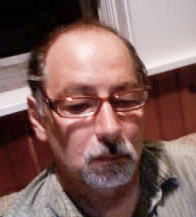 John (F.X, Compton, Damien) Sundman (Senegal 1974-76) grew up on a small farm in New Jersey, attended Xavier (Jesuit, military) High School on 16th Street Manhattan, earned a degree in anthropology from Hamilton College; did a two year rural development stint in Peace Corps (Senegal 1974-76); then: Purdue grad school agricultural economics; 25 years or so high tech hardware and software, Boston area & Silicon Valley; drop out, Martha’s Vineyard; truck driver, warehouseman, construction worker, working class hero, poverty & embarrassment. Wrote technoparanoid novel, metafictiony geekoid novella, dystopian illustrated phantasmagoria; back in and out of high tech; firefighter; husband, father of 3, essayist for Salon.com; food pantry worker. Website: johnsundman.com
John (F.X, Compton, Damien) Sundman (Senegal 1974-76) grew up on a small farm in New Jersey, attended Xavier (Jesuit, military) High School on 16th Street Manhattan, earned a degree in anthropology from Hamilton College; did a two year rural development stint in Peace Corps (Senegal 1974-76); then: Purdue grad school agricultural economics; 25 years or so high tech hardware and software, Boston area & Silicon Valley; drop out, Martha’s Vineyard; truck driver, warehouseman, construction worker, working class hero, poverty & embarrassment. Wrote technoparanoid novel, metafictiony geekoid novella, dystopian illustrated phantasmagoria; back in and out of high tech; firefighter; husband, father of 3, essayist for Salon.com; food pantry worker. Website: johnsundman.com

Great story, John, thank you for taking the time and brain cells to recollect and share.
Why thank you. It’s funny how the memories run deep, isn’t it?
I enjoyed your article too. My PC séjour was not nearly as isolated or hard as yours, but nevertheless life changing. Spent 77-79 at CILSS in Ouaga working on that drought issue and then in the 80s on the Riverbasin Development Project that launched the dams in the region that were supposed to alleviate drought. Hi Lillian!
That sounds fascinating. Never made it to Ouaga, but many of my friends did. Did you happen to run into a fellow named Al Fleming? He had been in Peace Corps somewhere in the Sahel in early 1970’s. I met him when we were graduate students in agricultural economics at Purdue studying various drought-related agricultrual projects in the region. I ended up going back to the Senegal River valley for 8 months of field research; I believe Al went to Ouaga in ’78 for similar work.
John, this is a wonderful, wonderful story. So, so positive. I loved the picture of you at at your small simple table. So easy to see how your experience there gave you real confidence in dealing with the future, even though you may not have realized it till decades later. Thanks again.
John Collins, Debre Marcos Ethiopia (1962-65)
Yeah, that’s correct. Only, I did realize some of the lessons pretty soon after my return. Certainly I found it easy to disassociate myself from people obsessed with money & material possessions.
I’ve been chatting a bit offline with John Coyne about Mike McCaskey, who evidently was a PCV in Ethiopia around the time that you were. I did not know Mike well, but I did meet him on a few occasions. I live on Martha’s Vineyard, where his family has a vacation residence. My wife Betty was, for many years, the coordinator of programming for adults at the Vineyard Haven Public Library; among other things she organized hundreds of lectures, including a talk by Mike — with dozens of his photos about a return to the village he had served in. Because he was going to be traveling on the day of his talk and wasn’t confident that he would be able to make it back to the island in time to give his talk. So, through my wife, he asked me to be his understudy.
So a week or so before his talk he & I met at the library & went over his script and all of his photos. As it turned out, he did arrive in time to give his talk and my services were not needed. But because I had taken the time to work with him enough to be his backup I really got a chance to see his quiet passion for Ethiopia and its people.
John, your post is enthralling! Have you written a book yet? I hope so.
I was in southern Senegal in the Fatick region from 1993-96. No electricity, no running water, a cement block house and latrine. And the most beautiful people I’ve ever known. It’s on the southern edge of the Sahel and there were several programs to reforest the area and grow crops. It worked in my village when a powerful chief took over and made people stop cutting down trees and plant things. The dry season was hell. But I did experience rains which came suddenly like jet planes roaring across the skies. I wrote a book, Roller Skating in the Desert, which is out of print now, but a few copies exist on amazon, sold by people who bought it long ago.
Ah, Senegal! Lillian! Hi! We’re still collaborating. There’s a mind-blowing PBS special, Starchasers of Senegal that was on a few weeks ago. A special astronomer in the Fatick area who is collaborating with NASA and they’re setting up a space station there.
Everything I hear about Senegal makes me so proud.
Jamm rekk!
Leita Kaldi Davis
RPCV Senegal 1993-96
Beautiful memoir. Fine writing – and very important. I was one of those 80 teachers you referenced as serving in Senegal (1975-77). I taught English in a public secondary school in Tambacounda. I traveled as I could (when not teaching, to which I was wholeheartedly dedicated) mostly to meet families of my 250 students in that eastern region, in villages and towns as far as Mali. A lifelong American friend I made during that time, though, was Ernie Stegeman (74-76), who must have been an animateur with you in the north. Sadly, he died in 2022. I was able to pay tribute to his life and service in company of his family in northern California in 2023. As Peace Corps approaches its 65th anniversary, our nation’s returned PC volunteers are passing away – silently, without much or any public recognition. Those returned volunteers I met were still grateful for their service experiences, but the nation should be, too. I served a second time as a Peace Corp Response volunteer in Guinea (2017-18), south of Senegal. I took four, two-week Farmer to Farmer volunteer assignments in Senegal (2012-2015), and worked in a Food for Education project in Congo-Brazzaville for 6 months in the winter of 2014-15. Each time I was able to work and volunteer in Africa has contributed collectively to the most meaningful, most rewarding, most humbling experiences of my life. I carry in my heart rich memories of so many, many people I met in West and Central Africa who daily demonstrated courage, decency, dignity, and profound joy in the face of tremendous hardships and difficulties. It gives me a peace that passes understanding.